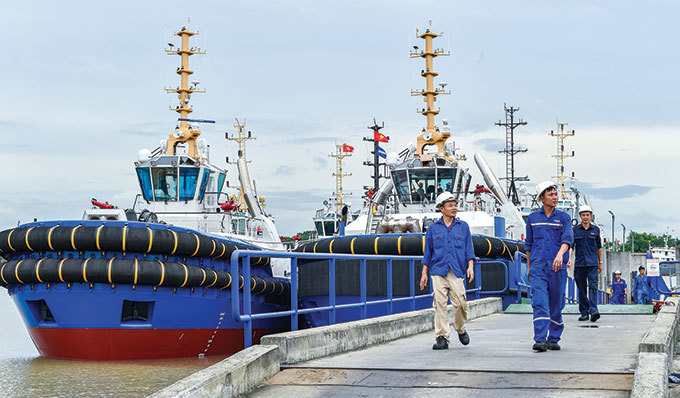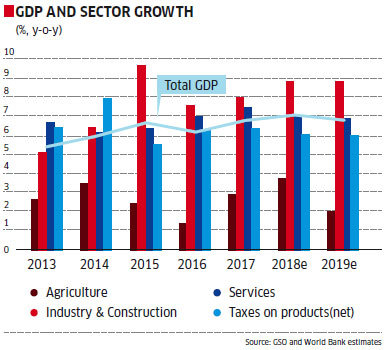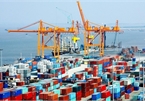 |
Vietnam’s economy has performed well in 2019. Import and export output is about to exceed the $500 billion mark; double the figure six years ago.
Inflation is low and the external economic situation has strengthened. In general, the macroeconomic fundamentals have also improved significantly.
Though the global trade environment is increasingly uncertain, Vietnam’s economy continues to show growth thanks to domestic demand and good results from the processing and manufacturing industry and exports.
All of these factors are prerequisites for Vietnam to post great economic growth, with GDP expanding 7.02 per cent by the end of 2019.
Notably, in the past few years, the Vietnamese Government has recognized the importance of the capital market, considering it a channel to mobilize long-term and diversified capital sources for domestic production.
We have seen a growing size and market share of government securities in the domestic stock market. This is also an opportunity to raise capital for Vietnam’s growth in the future and to diversify capital sources for the domestic private sector. In the World Bank’s latest economic update for Vietnam in 2019, released on December 17, we also advocate for the development of well-functioning capital markets due to this being a good time for Vietnam to boost such markets, find ways to diversify capital sources, reduce risks, and create opportunities for the domestic private sector to continue to grow.
However, some risks still exist. The international policy environment remains uncertain, including the possibility of escalating US-China trade tensions affecting and disrupting investment capital flows as well as international trade.
Regarding the domestic situation, we continue to be concerned that structural reforms are happening more slowly than expected, causing distortions in resource allocation and the business environment; affecting Vietnam’s long-term growth.
Therefore, structural reform is an important factor that the Vietnamese Government needs to promote.
In the coming time, if Vietnam expects to improve its competitiveness and growth and reach out to the world, free trade agreements (FTAs) will create conditions for it to have an open economy.
The government needs to consider whether FDI will continue to be a growth engine of the economy or if the country should rethink the form of FDI we need to attract.
Currently, the processing and manufacturing industry still plays an important role in attracting FDI, but in terms of research and development, what has Vietnam done to improve quality in the final stage of the supply chain in the production process?
Therefore, we also have to focus on the entire supply chain and research and development in the processing and manufacturing industry.
 |
In the long-term, to develop successfully and sustainably, Vietnam’s strategy must not only be attracting FDI.
State-owned and private enterprises need to invest in foreign markets and create capital to bring back to Vietnam for re-investment.
This is the direction we need to follow in the coming time. However, businesses need to have financial strategies and government support to reach out to the world.
For example, when Chinese enterprises reached out to the world a few years ago, they also felt confused.
Accordingly, the government issued a comprehensive policy on enterprise structure, strengthening the structure of the domestic private sector, which was previously fragmented, and bringing businesses together to create the power to reach out to the world.
Some Chinese industries have currently been able to compete in the international market. Therefore, Vietnam also determines the competitiveness of domestic enterprises to expand abroad.
In addition, the world now is changing fast, so it will belong to those who know how to use and control technology.
Therefore, digital transformation is extremely important for Vietnam in the future because it brings many benefits, such as improving transparency and helping to solve the problem of a lack of efficiency in the administrative apparatus.
However, this is a new problem and requires a different way of thinking and working. Accordingly, the view of some administrative apparatus is important to find and handle obstacles.
For example, the State agency thinks that retaining information will retain power instead of sharing, while information that is made public and shared will also bring many opportunities.
The World Bank will continue to support Vietnam in the development process, especially in macroeconomic stability, supporting the control of inflation.
We also continue to support ensuring investment quality improvements, of which we will focus more on infrastructure to generate revenue and boost growth.
We also want to support Vietnamese enterprises in improving their competitiveness and developing human resources, support the modernization of State management, promote e-government, and improve transparency.
The World Bank also supports dealing with environmental issues due to the fact they affect growth. We need to provide knowledge about learning experience from other successful middle-income countries, helping Vietnam move from a lower middle-income country and develop.
|
Vietnam’s economy has performed well in 2019, with GDP expanding 7.02 per cent, while public debt has reduced by almost 8 percentage point of GDP since 2016 and the country posted a trade surplus for the fourth year in a row. These results are remarkable in the context of a slowing global economy. The World Bank’s latest economic update for Vietnam in 2019, released on December 17, emphasizes the resilience of Vietnam’s economy. GDP growth has continued to be driven by a strong external sector, with exports expanding by about 8 per cent in 2019 - nearly four-fold faster than the world average. The country has also remained an attractive destination for foreign investors, with FDI inflows averaging $3 billion per month. In addition, private consumption has emerged as an important contributor to GDP growth as a result of an expanding middle class and rising wages. Private enterprises also increased their investment by 17 per cent during the same period. The prospects in the short to medium terms are good, as the World Bank forecasts GDP growth of around 6.5 per cent over the next few years. Vietnam’s economic fundamentals appear robust, and the government has built some fiscal space through its prudent fiscal policy. However, the country is not completely immune to external shocks, as demonstrated by the gradual decline in export growth from 21 per cent to 8 per cent between 2017 and 2019. This decline has been even more pronounced in non-US markets, rising only 3.6 per cent during the first eleven months of 2019. Greenfield FDI has also slowed by about 30 per cent over the past two years, even though it has been compensated by an increase in mergers and acquisitions. VN Economic Times |

2019: a year of strong growth for Vietnam telecommunications
Preparation for 5G, MNP (mobile number portability) and elimination of ‘trash’ simcards were the most noteworthy events in 2019.

Vietnam's GDP growth forecast robust for 2020
Vietnam would look to maintain economic growth of 6.76 per cent this year.
 Mr. Ousmane Dione, World Bank Country Director for Vietnam, discusses the growth in Vietnam's economy in 2019 and the prospects for 2020.
Mr. Ousmane Dione, World Bank Country Director for Vietnam, discusses the growth in Vietnam's economy in 2019 and the prospects for 2020.